In a normal 2020 season, this would have been an important year for a player like Amed Rosario. It would be his third full season in the major leagues, and the fourth that he’s been a part of overall. He hasn’t quite lived up to the hype of being a former top prospect. Rosario, of course, ranked as high as the third overall prospect in baseball prior to the 2017 season and was a unanimous top-ten prospect at the time. The good news is that he’s is still young, at just 24 years old. He’s the youngest player on the New York Mets projected 2020 26-man roster, beating the next-youngest player and fellow former top prospect, Dominic Smith, by five months. Being super young, Rosario certainly isn’t at risk of being pushed out of the league, but the Mets have quite a few other highly regarded middle infield prospects in their minor league system that are getting closer to the majors who could give Rosario a run for his money at the position sooner rather than later.
While the results have perhaps been underwhelming to this point, Rosario has continuously gotten better with each of the last few seasons. It is good to see improvement, as his season-long wRC+ totals have gone from 75 in 2017, to 85 in 2018, to an exactly league-average mark of 100 in 2019. League average offense is still valuable, and Rosario also provides more than that with his plus speed and improving defense, which could make him a nice, well-rounded player if he can continue to do that in the future.
Even more promising than the year-to-year offensive jumps is that we saw a glimpse of the ceiling Rosario could have at times last season. Most notably, in the second half of the season:
| Split | AVG | OBP | SLG | wOBA | BB% | K% | wRC+ |
|---|---|---|---|---|---|---|---|
| 1st Half | 0.260 | 0.290 | 0.414 | 0.300 | 5.3 | 22.2 | 88 |
| 2nd Half | 0.319 | 0.351 | 0.453 | 0.340 | 4.0 | 15.1 | 114 |
Rosario’s first half of 2019 was quite disastrous. While his 88 wRC+ was right in line with where it was the season prior, he had a jump in strikeout rate, and his plate discipline still wasn’t at a place that would make the team comfortable placing him at the top of the lineup on an everyday basis. In the second half, however, something seemed to click for Rosario. The walks were still not there, but he cut down on his strikeouts and got some more extra-base hits, allowing for a more complete slash line and a turnaround on the narrative of his season. With a 26-point improvement in wRC+, he had one the biggest one of the biggest reversals in the league.
This is good, obviously. Not just for his team and fantasy owners, but for the player, as that impressive second half from Rosario surely gave him some much-needed confidence in one of the hardest markets to play in. His defense at shortstop also improved greatly during the second half of the season and quelled any talk of him moving to the outfield. Now Rosario will get to play under a new manager in Luis Rojas, with whom he has played for in the past during his minor league career, and who was considered a big part of Rosario’s defensive turnaround. With all of this coming together, he finally looks like he’s ready to take off and become the player we all have been waiting for him to become.
However, Rosario has been one of the toughest players to evaluate for me personally. Just when I was about to write him off in 2019, he suddenly turned it on and had that run after the all-star break that makes me reconsider. It makes the upside hard to ignore. He should be a plus in the batting average department, with a good helping of stolen bases, and with mid-teens home run totals and the potential for more. I definitely can see why Rosario is intriguing in the world of fantasy baseball, with the market reflecting that in an ADP as high as 132 in the NFBC, going ahead of others with shortstop eligibility such as Corey Seager, Lourdes Gurriel, Jorge Polanco, and Gavin Lux, among others.
But then I take a closer look at his batted-ball peripherals, and I’m left even more confused. That’s why I am seeking some additional clarity on Rosario. Don’t get me wrong, Rosario did make some improvements offensively in the second half of 2019, but I’m not ultimately sold that his stats from that nice stretch are necessarily representative of the type of offensive player Rosario will be in the future, without further improvements and adjustments.
Let’s start by taking a closer look at some changes Rosario did make in 2019 that could set him up for future success. As mentioned in this post about him, one subtle adjustment he made in 2019 was where he was focusing his swings. Rosario has been a bit of a free swinger, but in 2019, he seemed to look for pitches in a more specific zone, rather than swinging at everything. For Rosario, the difference from 2018 to 2019 came from pitches in the center of the strike zone:
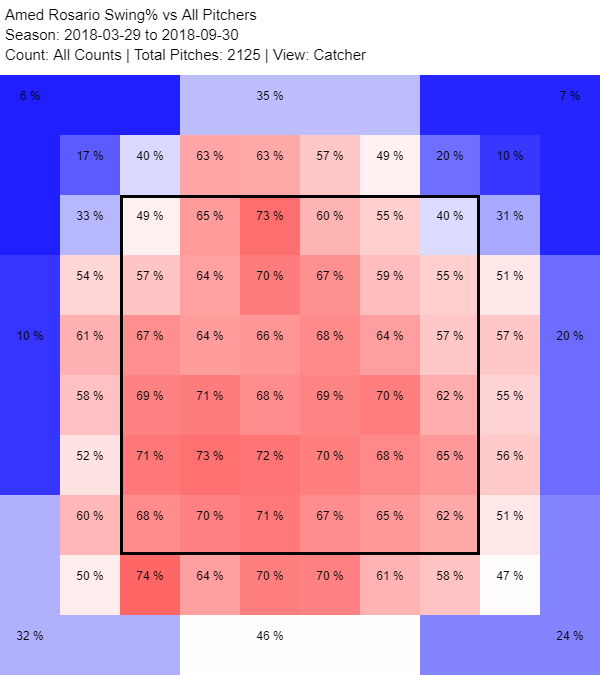
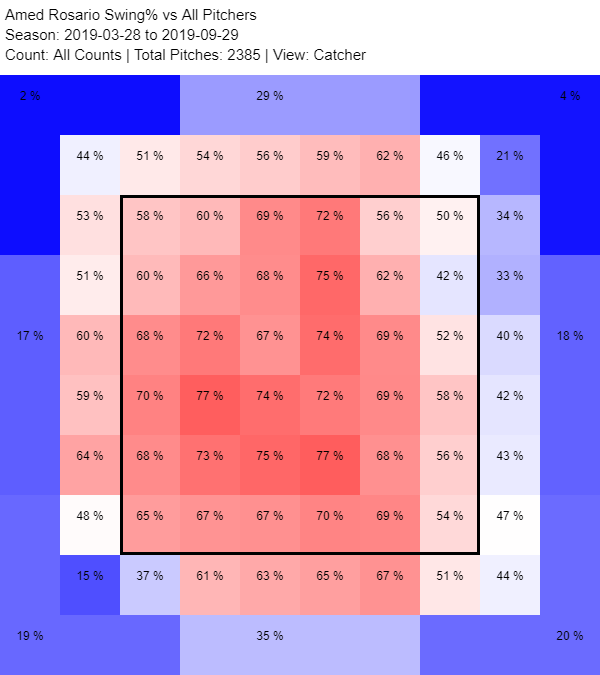
Rosario was still a frequent swinger in 2019 at 51.7% compared to the 46.6% league average, but he’s dropped his swing rate each season in the majors, and perhaps Rosario is getting a little more disciplined at the plate as he matures. He might not necessarily by laying off pitches out of the strike zone, but instead is looking for his pitch and swinging at it more often, and laying off more pitches that he maybe cannot quite handle.
This isn’t exactly the most “scientific” improvement to make. It’s a simple one, and one that certainly works for Rosario. Even more so when you realize that his hot zones in terms of slugging seem to match up to where he is most frequently swinging:
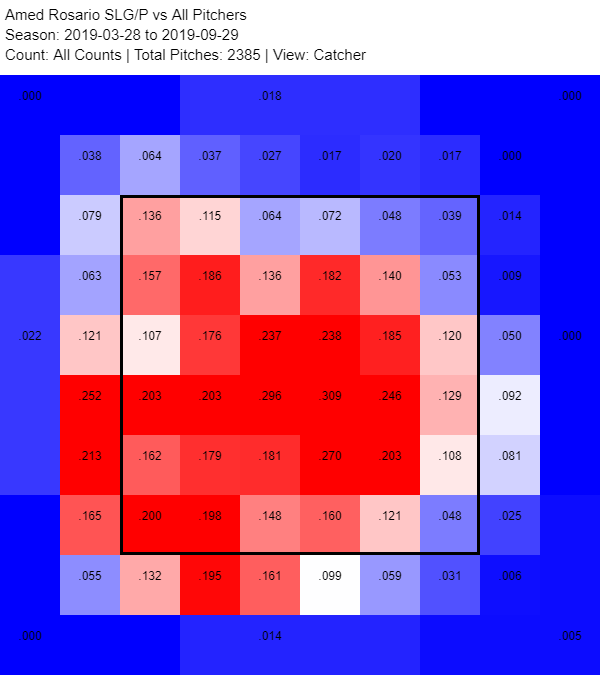
Rosario gets his best results on pitches in the middle-ish portion of the plate, so it makes sense to swing at more pitches in that area of the plate. He can certainly get even better in this area of his game in the future, which could help with his overall offensive production.
I mentioned it earlier, but Rosario’s overall swing rate has decreased each season he’s been in the Majors, hinting at some plate discipline improvements. Another subtle area where Rosario managed to improve last season was at which pitch types he was swinging at:
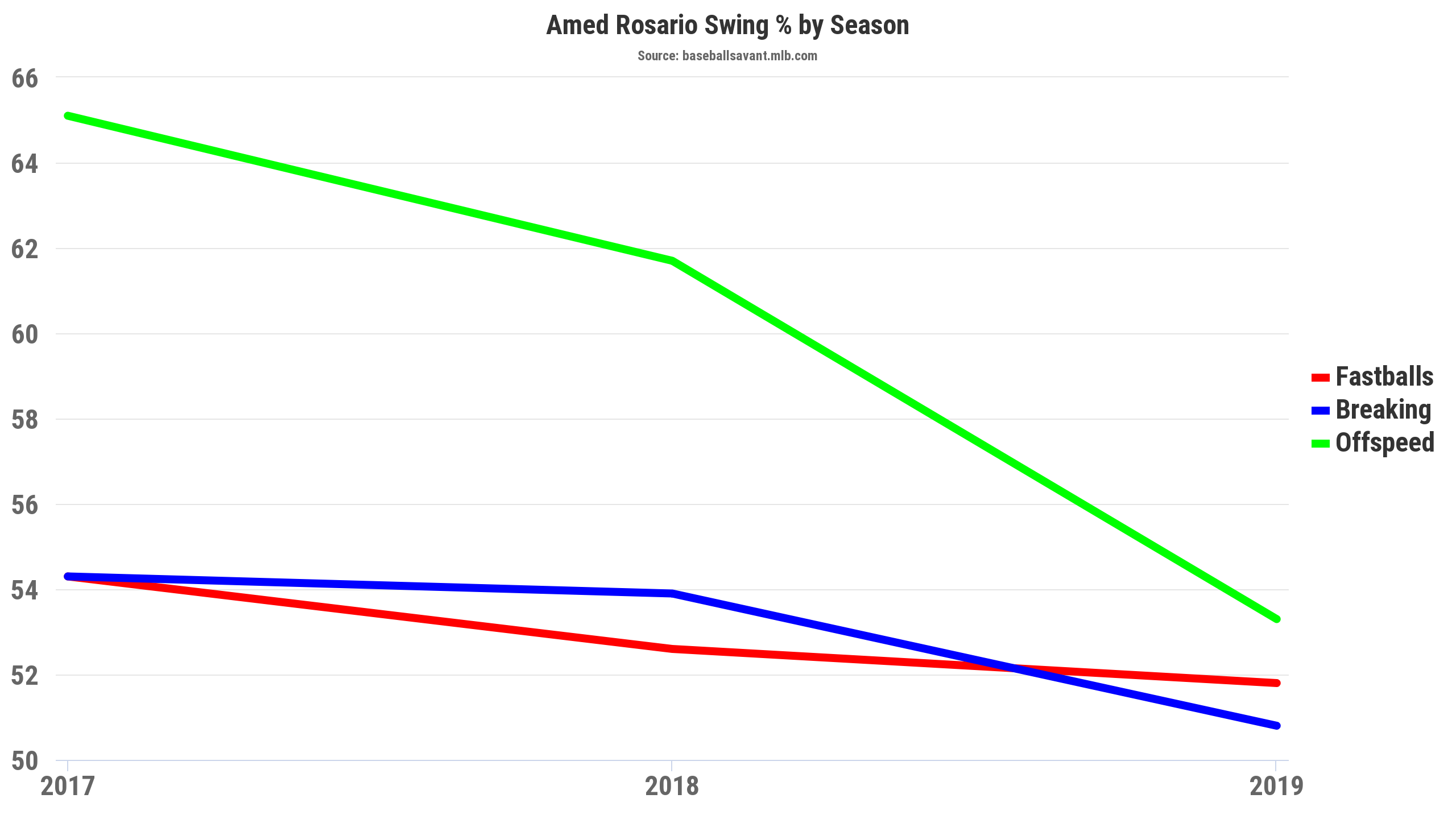
While Rosario is perhaps still swinging too much, he’s made pretty good improvements on laying off non-fastballs, while essentially keeping his swing rate on fastballs constant. A strategy that, again, is a simple but effective one, as non-fastballs have been Rosario’s kryptonite thus far in his career:
| Season | Pitch Type | wOBA |
|---|---|---|
| 2017 | Fastballs | 0.313 |
| 2017 | Breaking | 0.246 |
| 2017 | Offspeed | 0.264 |
| 2018 | Fastballs | 0.340 |
| 2018 | Breaking | 0.222 |
| 2018 | Offspeed | 0.261 |
| 2019 | Fastballs | 0.360 |
| 2019 | Breaking | 0.278 |
| 2019 | Offspeed | 0.242 |
Compared to his performance on breaking and offspeed pitches, Rosario is much better at handling fastballs, so it certainly seems logical to swing less at pitches that generate less optimal results. But now it’s time for the confusing part of all this. These improvements don’t necessarily make his Statcast metrics or batted-ball data look all that great.
Those results are no doubt in a better spot than where they once were, especially in the exit velocity and hard-hit department, as those two metrics have jumped to a rate that is now above average. His wOBA and xwOBA marks are right around league average now, too. However, when I take a closer look, especially into his hot second half, I am not fully convinced that these improvements on their own are enough to make his 2019 performance stick.
We already saw his second-half slash line was .319/.351/.453, but now let’s dive in a little deeper. Let’s start off by comparing some of his actual marks to his expected ones:
| SLG | xSLG | wOBA | xwOBA | wOBACON | xwOBACON | BABIP |
|---|---|---|---|---|---|---|
| 0.453 | 0.431 | 0.340 | 0.330 | 0.389 | 0.372 | 0.363 |
From this, we can see that the difference between some of his expected and actual stats isn’t all that big — like between his wOBA and xwOBA — but Rosario didn’t exactly have a profile in the second half of the season that would have supported his actual stats. While expected stats aren’t everything on their own, we should be able to find some reasons why Rosario’s expected metrics lagged behind his actual ones. First up, Rosario’s .363 BABIP in the second half was the 12th-highest out of 140 qualified hitters in that time span. Rosario does actually have a profile that would suggest strong BABIPs, so while this on its own isn’t super concerning, I will always be a little hesitant to believe that a .363 BABIP will sustain itself. Another notable thing that jumps out is that his August BABIP was .400 despite hitting 59% of his batted balls on the ground. This all happened while his average exit velocities dropped from their previous highs:
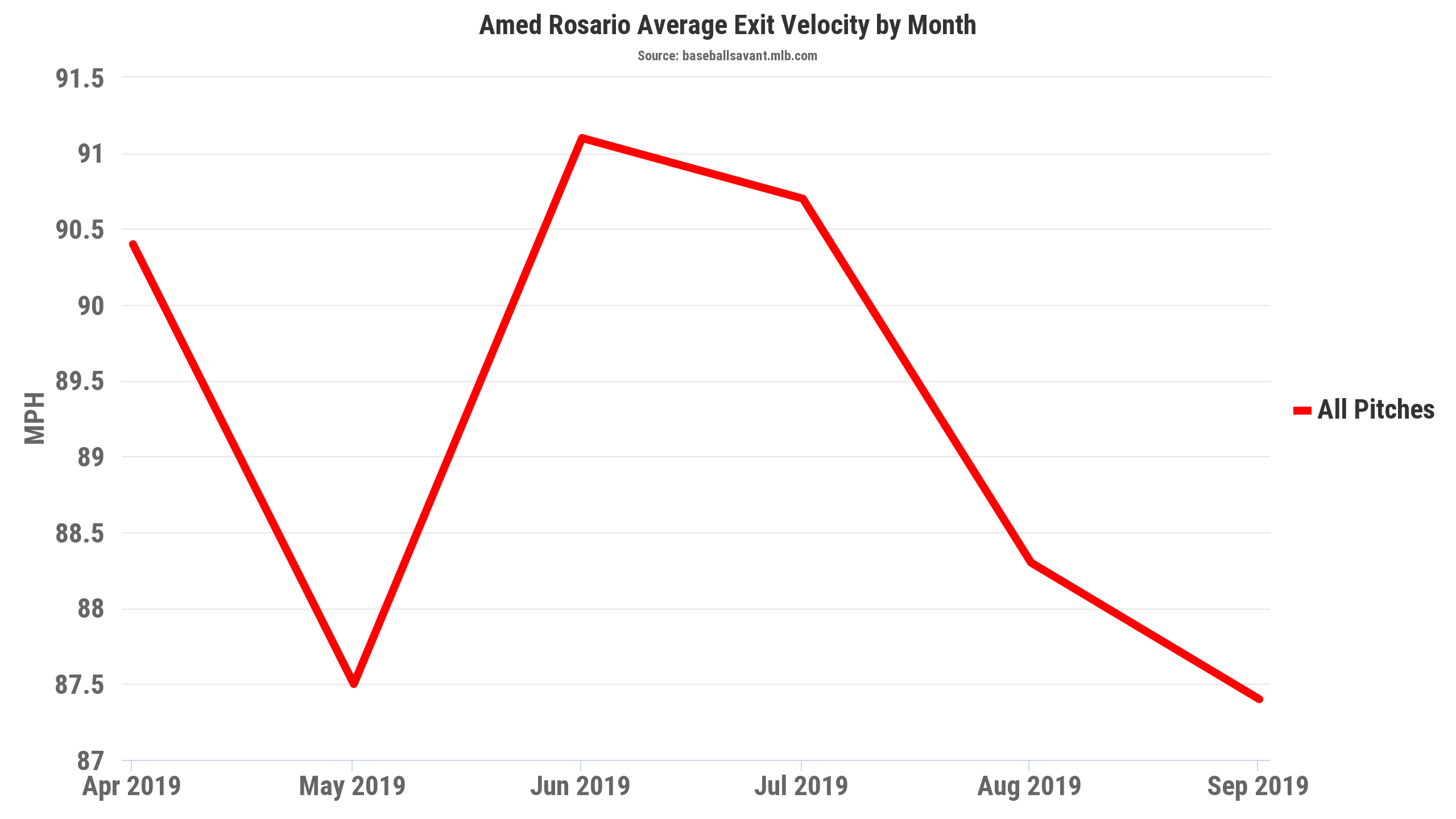
If Rosario had another month like his August of 2019 where he put nearly 60% of his batted balls on the ground, with a decline in exit velocity, I surely wouldn’t bet on him producing another monthly wRC+ of around 111, as he did then. And I’m sure that I’m not alone in that thinking.
Rosario’s 89.2 miles-per-hour average exit velocity in 2019 was in the 54th percentile by Statcast and is certainly an improvement from where it was in previous years, with a nearly two mph jump from where it was in 2018, but when breaking out his average exit velocity by batted-ball type, we get some mixed results:
| EV GB | EV LD | EV FB | EV FB+LD | AVG FB Dist. | |
|---|---|---|---|---|---|
| AVG MPH | 87.8 | 92.8 | 90.0 | 91.7 | 314 |
| Rank (out of 207) | 51 | 139 | 167 | 151 | 168 |
When compared to the 206 other hitters from 2019 that had at least 400 plate appearances, Rosario is towards the bottom of each category, except for his average exit velocity on ground balls mark. While it’s good to see that Rosario’s high BABIP can be at least partially explained by a good amount of hard-hit grounders, seeing Rosario’s sub-optimal results on the other batted ball types and his low average fly ball distance makes me hesitate when evaluating his power potential. While Rosario isn’t exactly the type of hitter that should be expected to pop 20 homers, based on these fly ball metrics, I’m not sure whether we can pencil in Rosario to match his .432 slugging mark from a season ago, or whether we can reasonably expect home run totals in the high-teens area either. Additionally, Rosario’s .769 slugging mark on fly balls in 2019 placed him 166th out of the same 207 hitters with at least 400 plate appearances, and his xSLG was even lower at .717, which places him at 170th. Rosario may not be a power hitter, but I would like for there to be more offensive upside if I’m drafting him over other shortstops such as Seager, Polanco, or Gurriel.
I guess it all comes down to what each fantasy player values more when assembling a roster. Batting average and steals are important for fantasy purposes, and Rosario certainly has a profile that will play to those categories, but I personally care about those categories the least. Hopefully he can continue to build on the improvements that turned around his 2019. However, when evaluating some other areas of his game, Rosario’s strong second half may be unsustainable.
I believe Rosario is the type of hitter that would thrive more at the top of the lineup, where he can set the table and use his 94th percentile sprint speed to score plenty of runs that will be driven in by the Mets big boppers in Pete Alonso, Michael Conforto, and JD Davis. While Rosario’s plate discipline has gotten better, it still isn’t where it needs to be for the Mets to justify placing him in the leadoff spot over other on-base machines such as Jeff McNeil or Brandon Nimmo, which would have an impact on his runs scored. Additionally, plus speed doesn’t seem to equal stolen bases for Rosario, as he was caught stealing 10 times in 29 attempts last year, which was tied for the league lead, and had just a 56% stolen base success rate in the second half of the season. I would want to see how much Rojas lets the team run, and more specifically how much they would want Rosario running while hitting him at the bottom of the order, before I draft Rosario for his stolen base upside.
Overall, I definitely see the intrigue regarding Rosario, and it’s good to see him finally settling in as a major leaguer, getting his wRC+ to a league-average mark, and also seeing his defense take a step forward. He was nearly a three win player last season, and if he can match that in future seasons he should have a long and productive career. Barring another major improvement, though, I would predict a similar season to the one Rosario just had, at least in terms of rate stats. That isn’t bad, but I’m not sure his ceiling is much higher.
Photo by Brian Rothmuller/Icon Sportswire | Adapted by Justin Paradis (@freshmeatcomm on Twitter)


Very well written, Matt. I agree with the majority of your hypotheses. I’m sure we are all really hoping that Rojas lets these guys run.
Thanks for the kind words, glad you liked it!
It will be really interesting to see how much the Mets coaches/front office lets them run. Rosario got caught a lot in the past, which I’m sure nobody is happy about, but maybe it’s another area where he can still get better.